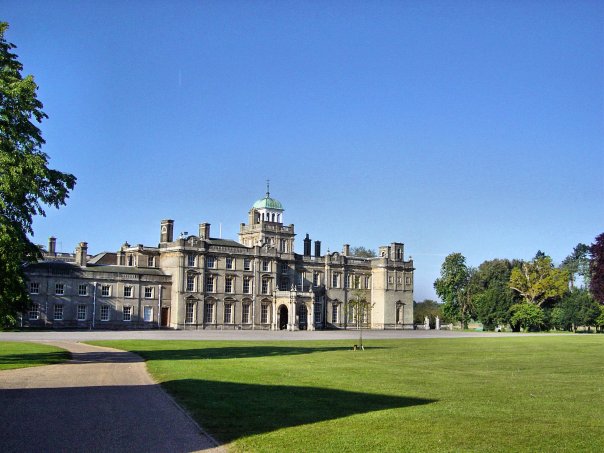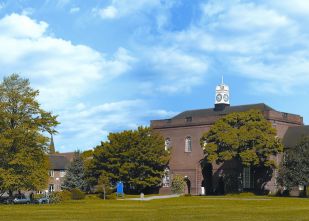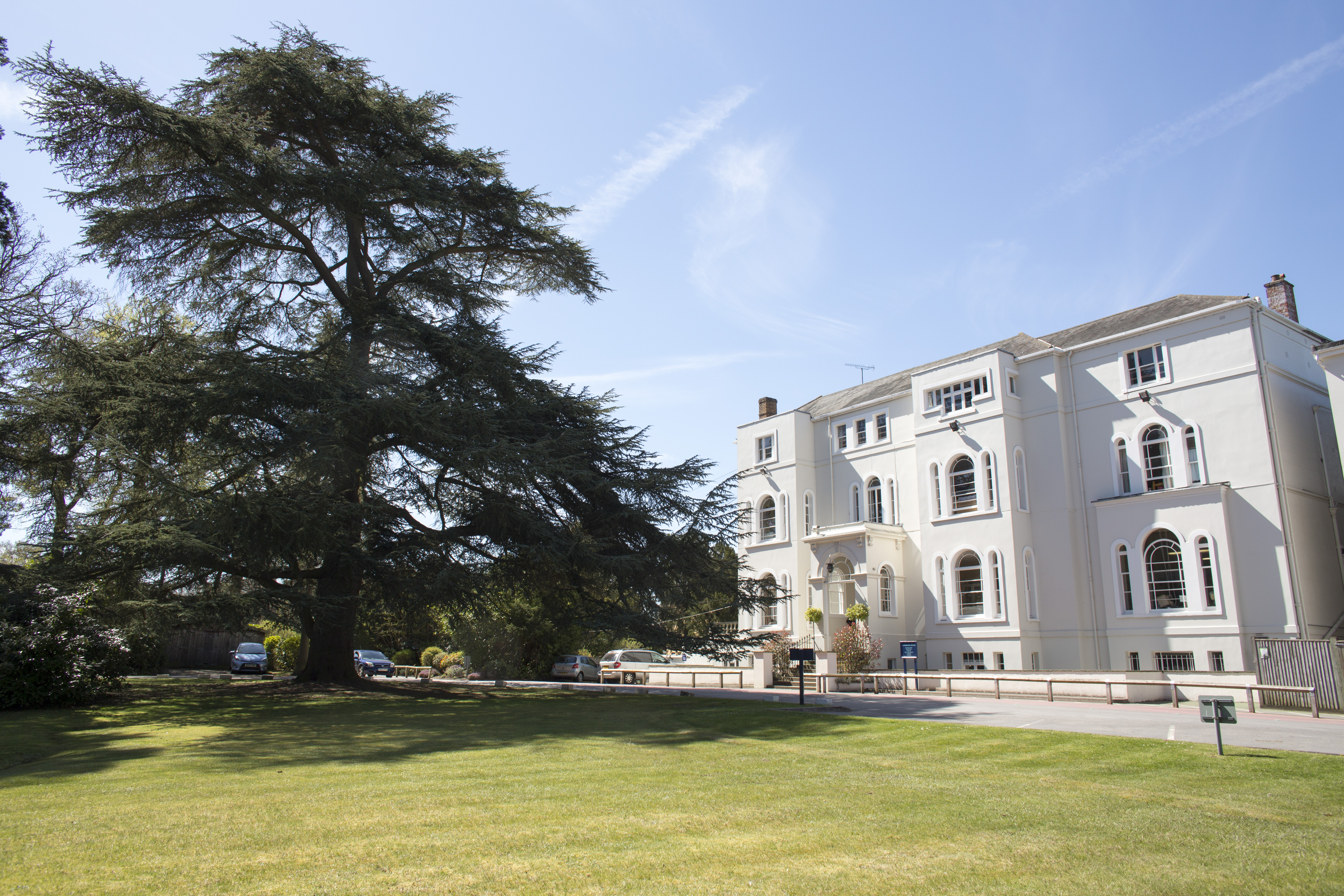|
Culford School
Culford School is a co-educational independent day and boarding school for pupils age 1-18 in the village of Culford, miles north of Bury St Edmunds in Suffolk, England. The headmaster is a member of the Headmasters' and Headmistresses' Conference and the Prep School is a member of the IAPS. History The school was founded as the East Anglian School for Boys, incorporating an institution founded in 1873 by Congregationalist minister, Dr John H. L. Christien. It was one of a group of Methodist schools established in response to the growth of the middle class, the launching of the Woodard Schools and the 1867 Taunton Commission, which fuelled an expansion of secondary education in general and of non-conformist boarding schools in particular. The original school was in Northgate Street in Bury St Edmunds, but in 1886 it moved to Thingoe Hill in the town (a site later occupied by the East Anglian School for Girls). In 1935 the school moved to Culford Park. This is the former seat ... [...More Info...] [...Related Items...] OR: [Wikipedia] [Google] [Baidu] |
Independent School (UK)
In the United Kingdom, independent schools () are fee-charging schools, some endowed and governed by a board of governors and some in private ownership. They are independent of many of the regulations and conditions that apply to state-funded schools. For example, pupils do not have to follow the National Curriculum, although, some schools do. They are commonly described as 'private schools' although historically the term referred to a school in private ownership, in contrast to an endowed school subject to a trust or of charitable status. Many of the older independent schools catering for the 12–18 age range in England and Wales are known as public schools, seven of which were the subject of the Public Schools Act 1868. The term "public school" derived from the fact that they were then open to pupils regardless of where they lived or their religion (while in the United States and most other English-speaking countries "public school" refers to a publicly-funded state school). ... [...More Info...] [...Related Items...] OR: [Wikipedia] [Google] [Baidu] |
Culford Park
Culford Park in Culford, Suffolk, England, is a country house that is the former seat of the Bacon, Cornwallis and Cadogan families, and now it is the home of Culford School. History of the Park From at least 1429 the Coote family had lived at Culford and in 1524 Christopher Coote was lord of the manor. In 1540 Culford was granted by the Crown to the Bacon family and in 1591 Sir Nicholas Bacon built a red-brick hall on the same site as the present house. The estate passed to the Cornwallis family in 1660 and during the middle of the C18 'T Wright' (possibly Thomas Wright (1711(86), the nationally renowned landscape gardener) was employed. Wright produced a map of the park dated 1742 which shows a formal landscape of avenues, rides and vistas, through geometrically shaped blocks of woodland. Between 1790 and 1796 Samuel Wyatt was commissioned to remodel the house for the first Marquis Cornwallis and in 1791 Humphry Repton (1752-1818) provided advice on landscaping the park, pr ... [...More Info...] [...Related Items...] OR: [Wikipedia] [Google] [Baidu] |
Charles Cornwallis, 1st Marquess Cornwallis
Charles Cornwallis, 1st Marquess Cornwallis, (31 December 1738 – 5 October 1805), styled Viscount Brome between 1753 and 1762 and known as the Earl Cornwallis between 1762 and 1792, was a British Army general and official. In the United States and the United Kingdom, he is best remembered as one of the leading British generals in the American War of Independence. His surrender in 1781 to a combined American and French force at the siege of Yorktown ended significant hostilities in North America. He later served as a civil and military governor in Ireland, where he helped bring about the Act of Union; and in India, where he helped enact the Cornwallis Code and the Permanent Settlement. Born into an aristocratic family and educated at Eton and Cambridge, Cornwallis joined the army in 1757, seeing action in the Seven Years' War. Upon his father's death in 1762 he became Earl Cornwallis and entered the House of Lords. From 1766 until 1805 he was Colonel of the 33rd Regimen ... [...More Info...] [...Related Items...] OR: [Wikipedia] [Google] [Baidu] |
Culford School L
Culford is a village and civil parish about north of Bury St Edmunds and north east of London in the West Suffolk district of Suffolk, England. According to the 2011 Census the parish had a population of 578, a decrease from 620 recorded at the 2001 census. A tributary of the River Lark, known as Culford Stream, flows through the centre of the village being fed from Ampton Water in Great Livermere. It continues Westward into West Stow before joining the River Lark at Clough Staunch on the edge of Lackford Lakes. The main village developed along a straight road called "The Street" and there are also some smaller residential areas in Culford, like Benyon gardens, a complex of cul-de-sacs. Most of the houses in central Culford date from the second half of the 1800s and were built as part of the Culford Estate while those at the edges of the village are post-war and later. The centre of the village, along with the Park, and most of West Stow is a conservation area which was e ... [...More Info...] [...Related Items...] OR: [Wikipedia] [Google] [Baidu] |
Eric Ashby, Baron Ashby
Eric Ashby, Baron Ashby, FRS (24 August 1904 – 22 October 1992) was a British botanist and educator. Born in Leytonstone in Essex, he was educated at the City of London School and the Royal College of Science, where he graduated with a Bachelor of Science. He was then demonstrator at the Imperial College from 1926 to 1929. In 1929, he received a Harkness Fellowship to the University of Chicago. Ashby was a lecturer at Imperial College from 1931 to 1935, and at the University of Bristol from 1935 to 1938. Marriage Ashby married Elizabeth Helen Margaret Farries, whom he met while they were working together on incineration techniques for measuring carbon in tissue. They had two children, Michael and Peter. Career In 1938, Ashby became professor of botany at the University of Sydney, a post he held until 1946. Between 1944 and 1945, he was Scientific Counsellor to Moscow. From 1947 to 1950, he held the Harrison Chair of Botany at the University of Manchester. According to ... [...More Info...] [...Related Items...] OR: [Wikipedia] [Google] [Baidu] |
Eleven-plus
The eleven-plus (11+) is a standardized examination administered to some students in England and Northern Ireland in their last year of primary education, which governs admission to grammar schools and other secondary schools which use academic selection. The name derives from the age group for secondary entry: 11–12 years. The eleven-plus was once used throughout England and Wales, but is now only used in counties and boroughs in England that offer selective schools instead of comprehensive schools. Also known as the transfer test, it is especially associated with the Tripartite System which was in use from 1944 until it was phased out across most of the UK by 1976. The examination tests a student's ability to solve problems using a test of verbal reasoning and non-verbal reasoning, with most tests now also offering papers in mathematics and English. The intention was that the eleven-plus should be a general test for intelligence (cognitive ability) similar to an IQ test, but ... [...More Info...] [...Related Items...] OR: [Wikipedia] [Google] [Baidu] |
Direct Grant Grammar School
A direct grant grammar school was a type of selective secondary school in the United Kingdom that existed between 1945 and 1976. One quarter of the places in these schools were directly funded by central government, while the remainder attracted fees, some paid by a Local Education Authority and some by the pupils' parents or guardians. On average, the schools received just over half of their income from the state. The status was introduced in England and Wales by the Education Act 1944 as a modification of an existing direct grant scheme to some long standing endowed grammar schools. There were 179 direct grant grammar schools, which, together with over 1,200 grammar schools maintained by local authorities, formed the most academic tier of the Tripartite System. They varied greatly in size and composition, but, on average, achieved higher academic results than either maintained grammar schools or independent schools. State secondary education was reorganised on comprehensive ... [...More Info...] [...Related Items...] OR: [Wikipedia] [Google] [Baidu] |
Preparatory School (UK)
A preparatory school (or, shortened: prep school) in the United Kingdom is a fee-charging independent primary school that caters for children up to approximately the age of 13. The term "preparatory school" is used as it ''prepares'' the children for the Common Entrance Examination in order to secure a place at an independent secondary school, typically one of the English public schools. They are also preferred by some parents in the hope of getting their child into a state selective grammar school. Most prep schools are inspected by the Independent Schools Inspectorate, which is overseen by Ofsted on behalf of the Department for Education. Overview Boys' prep schools are generally for 8-13 year-olds, who are prepared for the Common Entrance Examination, the key to entry into many secondary independent schools. Before the age of 7 or 8, the term "pre-prep school" is used. Girls' independent schools in England tend to follow the age ranges of state schools more closely than th ... [...More Info...] [...Related Items...] OR: [Wikipedia] [Google] [Baidu] |
Humphry Repton
Humphry Repton (21 April 1752 – 24 March 1818) was the last great English landscape designer of the eighteenth century, often regarded as the successor to Capability Brown; he also sowed the seeds of the more intricate and eclectic styles of the 19th century. His first name is often incorrectly rendered "Humphrey". Biography Early life Repton was born in Bury St Edmunds, the son of a collector of excise, John Repton, and Martha (''née'' Fitch). In 1762 his father set up a transport business in Norwich, where Humphry attended Norwich Grammar School. At age twelve he was sent to the Netherlands to learn Dutch and prepare for a career as a merchant. However, Repton was befriended by a wealthy Dutch family and the trip may have done more to stimulate his interest in 'polite' pursuits such as sketching and gardening. Returning to Norwich, Repton was apprenticed to a textile merchant, then, after marriage to Mary Clarke in 1773, set up in the business himself. He was not successf ... [...More Info...] [...Related Items...] OR: [Wikipedia] [Google] [Baidu] |
Cambridge
Cambridge ( ) is a university city and the county town in Cambridgeshire, England. It is located on the River Cam approximately north of London. As of the 2021 United Kingdom census, the population of Cambridge was 145,700. Cambridge became an important trading centre during the Roman and Viking ages, and there is archaeological evidence of settlement in the area as early as the Bronze Age. The first town charters were granted in the 12th century, although modern city status was not officially conferred until 1951. The city is most famous as the home of the University of Cambridge, which was founded in 1209 and consistently ranks among the best universities in the world. The buildings of the university include King's College Chapel, Cavendish Laboratory, and the Cambridge University Library, one of the largest legal deposit libraries in the world. The city's skyline is dominated by several college buildings, along with the spire of the Our Lady and the English Martyrs ... [...More Info...] [...Related Items...] OR: [Wikipedia] [Google] [Baidu] |
Ipswich
Ipswich () is a port town and borough in Suffolk, England, of which it is the county town. The town is located in East Anglia about away from the mouth of the River Orwell and the North Sea. Ipswich is both on the Great Eastern Main Line railway and the A12 road; it is north-east of London, east-southeast of Cambridge and south of Norwich. Ipswich is surrounded by two Areas of Outstanding Natural Beauty (AONB): Suffolk Coast and Heaths and Dedham Vale. Ipswich's modern name is derived from the medieval name ''Gippeswic'', probably taken either from an Anglo-Saxon personal name or from an earlier name given to the Orwell Estuary (although possibly unrelated to the name of the River Gipping). It has also been known as ''Gyppewicus'' and ''Yppswyche''. The town has been continuously occupied since the Saxon period, and is contested to be one of the oldest towns in the United Kingdom.Hills, Catherine"England's Oldest Town" Retrieved 2 August 2015. Ipswich was a settleme ... [...More Info...] [...Related Items...] OR: [Wikipedia] [Google] [Baidu] |
Norwich
Norwich () is a cathedral city and district of Norfolk, England, of which it is the county town. Norwich is by the River Wensum, about north-east of London, north of Ipswich and east of Peterborough. As the seat of the See of Norwich, with one of the country's largest medieval cathedrals, it is the largest settlement and has the largest urban area in East Anglia. The population of the Norwich City Council local authority area was estimated to be 144,000 in 2021, which was an increase from 143,135 in 2019. The wider built-up area had a population of 213,166 in 2019. Heritage and status Norwich claims to be the most complete medieval city in the United Kingdom. It includes cobbled streets such as Elm Hill, Timber Hill and Tombland; ancient buildings such as St Andrew's Hall; half-timbered houses such as Dragon Hall, The Guildhall and Strangers' Hall; the Art Nouveau of the 1899 Royal Arcade; many medieval lanes; and the winding River Wensum that flows through the city ... [...More Info...] [...Related Items...] OR: [Wikipedia] [Google] [Baidu] |











